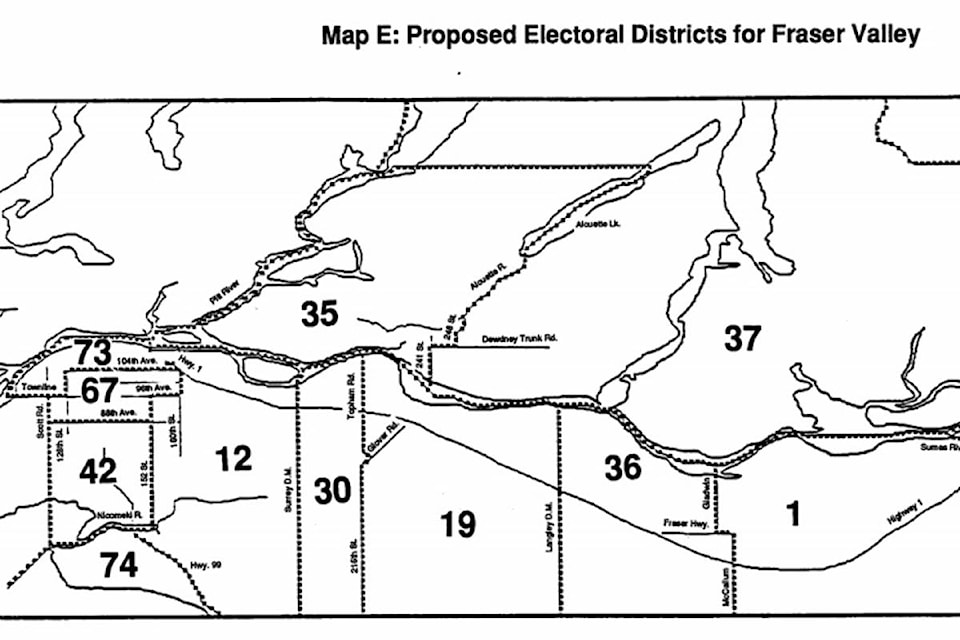Provincial election day in Langley has changed many times over the course of B.C.’s history.
Until 1940, for example, it was still legally required for the local returning officer to announce “Oyez! Oyez! Oyez!” on election day, a shout historically used by town criers.
And while it’s pretty easy to determine which riding you’re in now – all Langley residents are in a riding that starts with the word “Langley” or “Abbotsford” – that was not the case for many decades.
In 1871, in British Columbia’s first provincial election as a new province in Canada, the area that would become Langley was part of a single vast New Westminster district. It included all of the Lower Mainland, including Vancouver – then little more than a logging camp – and the entire west coast of the province, with the exception of Vancouver Island.
Across the new province, a total of 3,804 votes were cast that year. Only men, over 21, who met certain property ownership requirements, were eligible to vote. People voted by raising their hands. The secret ballot wouldn’t come into force until the next election.
Early elections included wide-ranging bans on certain groups voting.
Women were prohibited until 1917, and governments banned Indigenous people for decades. Bans also targeted Canadians of Japanese, Chinese, and South Asian descent, and the Mennonite, Hutterite, and Doukhobor religious communities.
In addition, at various times provincial or federal government employees, school teachers, prisoners in B.C. jails, and seniors living in provincial homes for the aged were banned from voting.
In the early 20th century, when Langley was still a community of Indigenous people, farmers, loggers, and a few shopkeepers, it was part of the vast Delta riding, which covered all of what is now Delta, Surrey, White Rock, and Langley. To the east, the riding of Chilliwack swallowed up Abbotsford and Sumas, too.
That arrangement stayed remarkably stable into the mid-20th century, but the B.C. Legislature, responding to increasing population, added more MLAs instead of splitting the ridings.
For much of B.C.’s history, ridings had two, or in a few cases, three MLAs representing them. The last multi-member ridings stuck around until the election of 1991, despite the fact that there had been calls for their elimination as early as the 1966 Angus Commission.
The political geography of Langley was different, and sometimes, so were political choices.
In the early 20th century, the main choices for voters were Liberal or Conservative, though a small number of ridings elsewhere in B.C. returned Socialist candidates to the Legislature. Delta flipped back and forth between the two main parties, but there were other choices as well.
In 1920, in the wake of the First World War, the Soldier-Farmer Party came second in the riding. Ex-soldiers ran in ridings across the country under similar party names.
By the time of the Great Depression in 1933, Delta riding voters abruptly changed their allegiance, electing Robert Swailes of the Co-operative Commonwealth Federation (CCF), the forerunner to the NDP. The Liberals were a close second.
However, in such a large riding, Langley itself might not have been voting for the CCF, noted Bob Groeneveld, retired longtime editor of the Langley Advance.
“It was not Langley that was electing them,” Groeneveld said of the CCF and NDP politicians who sometimes represented the riding. Langley was often a more conservative portion of the riding as a whole.
The next party to hold the Delta seat wasn’t a real party at all – in 1945, the Coalition – a wartime alliance of Liberals and Conservatives – wrested the riding from the CCF.
They would hold it until 1952, when one of the province’s great electoral earthquakes struck. Under the leadership of W.A.C. Bennett, the Social Credit Party swept to majority government that year, including in Delta. Bennett and his party would hold power in the Legislature 20 more years, until 1972.
In 1956, the Delta riding saw its first major transformation, when it got a second MLA. Both were Social Credit members.
The CCF would turn that around in the 1960 election, when it won, sending two members to the opposition benches.
The next big change came in 1966, when the ridings were finally realigned as a result of the Angus Commission report. The Langley riding had finally been born. The Lower Mainland as a whole jumped from 19 ridings to 27 that year, a result of people flooding into fast-growing suburban communities, including Langley.
Although the Angus Commission had called for scrapping two- and three-member ridings, they stuck around, and as Langley grew, it became a two member district in 1986.
Finally, two-member ridings were abolished just before the 1991 election.
A 1988 report of the Electoral Boundaries Commission was the first to slice Langley into two ridings, with what became Langley taking much of the western portion of the community, and Fort Langley-Aldergrove the eastern portions. That would remain the standard, with boundary tweaks, until Fort Langley-Aldergrove was renamed Langley East and parts of Aldergrove were moved into Abbotsford ridings in 2017.
That change was not the only momentous one for the local ridings.
The 1991 election was the second political earthquake of the century. Dogged by scandals from the premiership of Bill Vander Zalm, the Social Credit vote collapsed.
“It was like everywhere else, mostly unexpected,” Groeneveld recalled.
The NDP’s victory was predicted, but the third-party Liberals won in Langley and in Fort Langley-Aldergrove, and in a number of other ridings, becoming the official opposition.
They would hold both of Langley’s main ridings, as well as its neighbours in Abbotsford, for the next 31 years to the present day.
